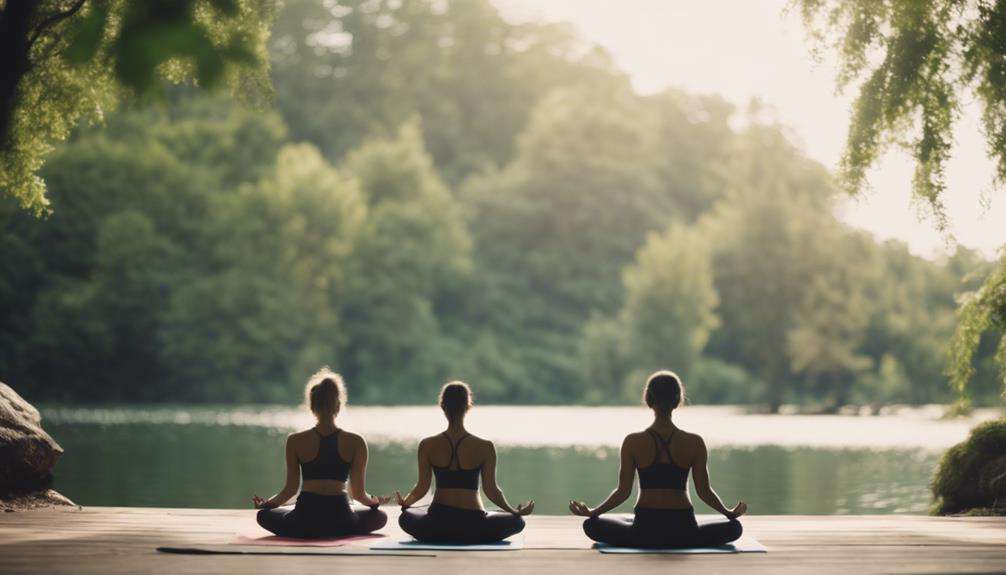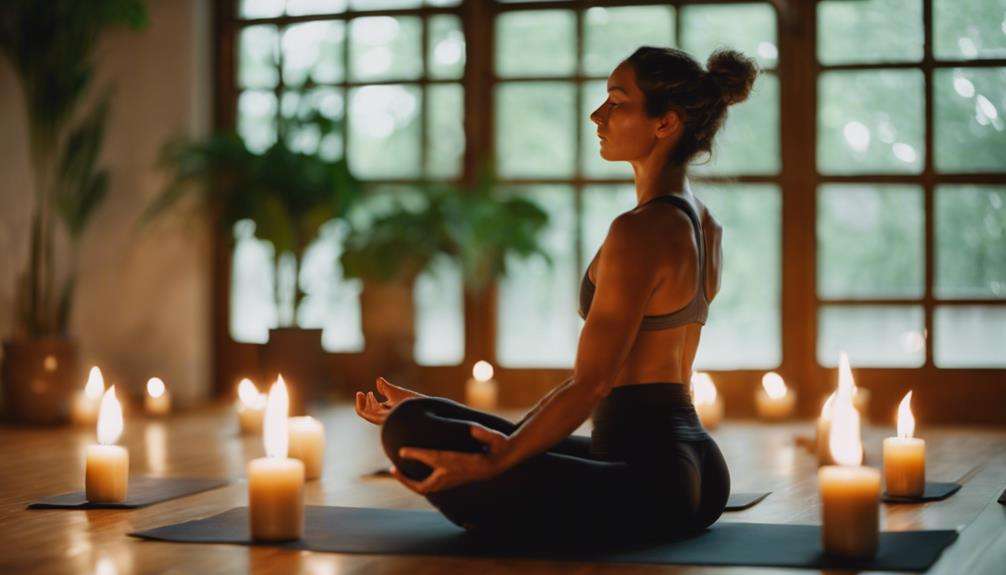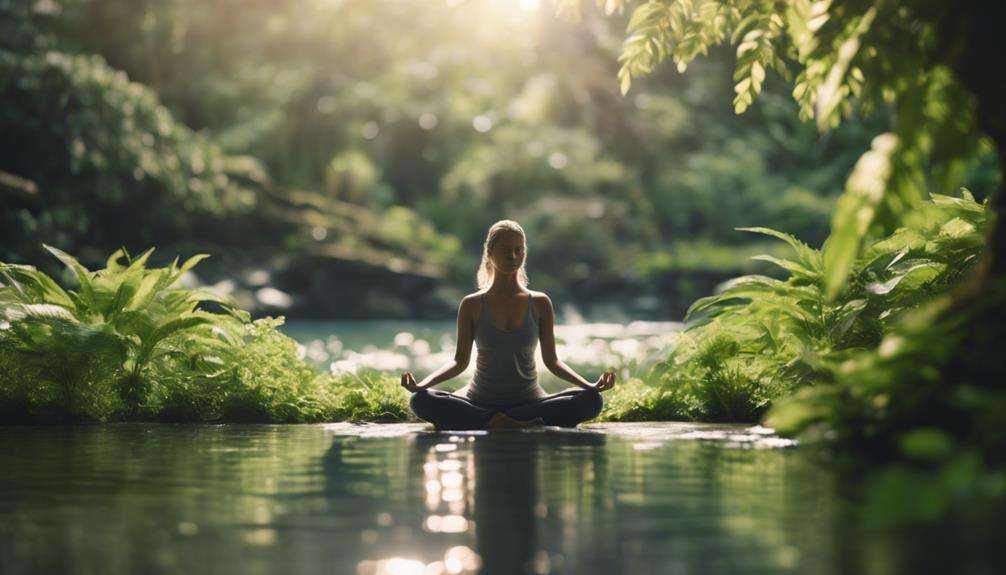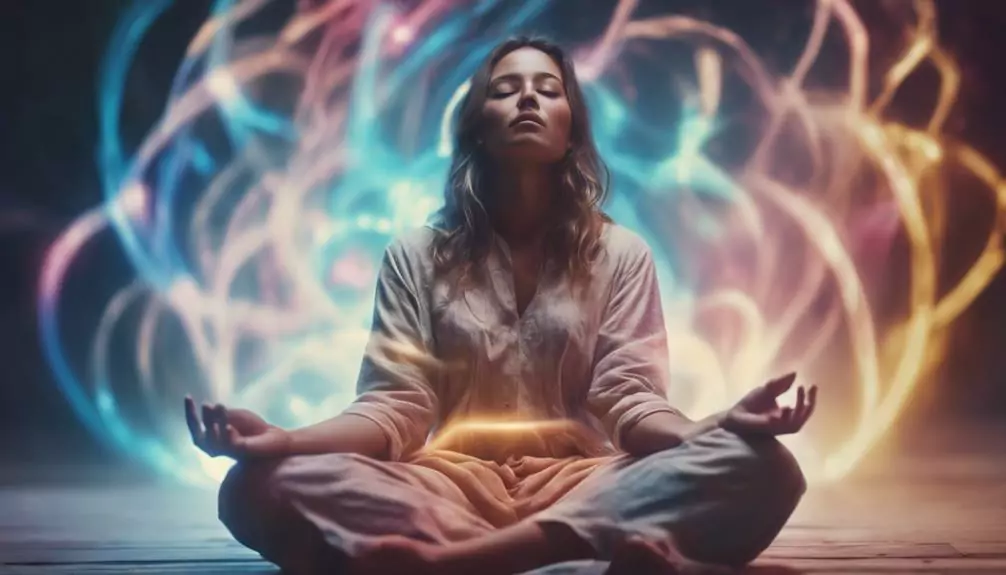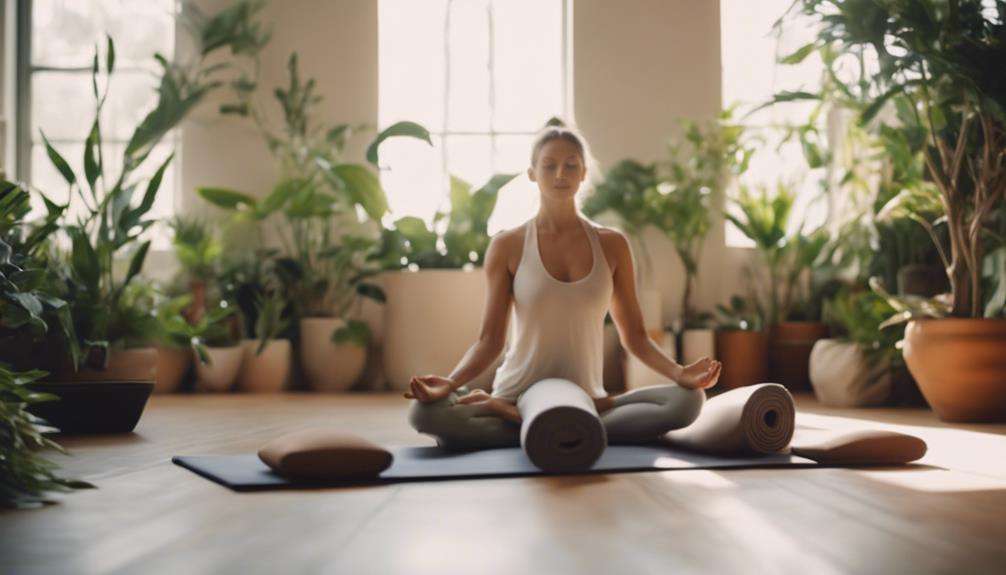Feeling like you can never truly wind down and relax? With these 10 expert tips for deep relaxation and mindfulness using Yoga Nidra, you'll discover a pathway to a serene state of being that may surprise you.
From simple body positioning techniques to powerful breath awareness exercises, each tip is designed to guide you towards a tranquil mind-body connection that can enhance your overall well-being.
So, are you ready to unlock the secrets to profound relaxation and mindfulness with Yoga Nidra?
Key Takeaways
- Yoga Nidra enhances mindfulness, relaxation, and self-awareness.
- Create a serene environment for deep relaxation during practice.
- Incorporate mindfulness techniques like breath awareness and Sankalpa.
- Integrate Yoga Nidra into daily life for increased inner peace and self-awareness.
Benefits of Yoga Nidra for Mindfulness
Experience the transformative benefits of Yoga Nidra for mindfulness as it guides you towards deep relaxation and self-awareness. Yoga Nidra, a form of guided meditation, is a powerful tool for stress reduction and improving sleep quality. By engaging in this practice, you can enhance your self-awareness and cultivate a sense of inner peace.
Through the combination of yoga, meditation, and mindfulness techniques, Yoga Nidra allows you to enter a state of deep relaxation while remaining fully alert. This practice not only helps calm the mind but also sharpens your focus and overall well-being. By following the verbal cues for breathing and visualization while lying down comfortably, you can experience profound levels of relaxation and mental clarity.
Embrace the benefits of Yoga Nidra to connect with your inner self, reduce stress, and elevate your mindfulness practice to new heights.
Setting the Mood for Yoga Nidra
To set the mood for a successful Yoga Nidra practice, ensure that your environment is tranquil by dimming lights and eliminating distractions. Creating a peaceful atmosphere is essential for deep relaxation. Consider using calming essential oils like lavender or chamomile to enhance the sense of tranquility. Soft, soothing music or nature sounds can also contribute to a serene ambiance during your practice.
Settle into a comfortable position on a supportive surface to fully relax your body and mind. Find a spot where you feel at ease and can let go of tension. Using props like blankets or bolsters can provide added comfort and help you maintain a relaxed posture throughout the session. By setting up your space thoughtfully and mindfully, you pave the way for a deeper experience of Yoga Nidra, allowing yourself to fully immerse in the practice and reap its benefits.
Creating a Sacred Space

Find a quiet spot in your home where you can unwind and focus on your Yoga Nidra practice.
Set the mood by ensuring the space is clutter-free, softly lit, and filled with comforting props.
Personalize this area with items that hold special significance to you, creating a sacred environment that enhances your relaxation experience.
Calming Ambiance Setup
For creating a sacred space conducive to deep relaxation during Yoga Nidra, ensure you select a quiet, clutter-free area with soft lighting and minimal distractions. To enhance the calming ambiance, consider the following:
- Incorporate Elements: Use candles, essential oils, calming music, or natural sounds to elevate the relaxation experience.
- Comfortable Props: Support your body with bolsters, blankets, and cushions for a more relaxing practice.
- Personal Touches: Add photos, crystals, or meaningful objects to make the space feel sacred and inviting.
Personalized Comfort Elements
Enhance your sacred space for deep relaxation by incorporating personalized comfort elements that resonate with your sense of peace and joy. During your Yoga Nidra practice, surround yourself with comfortable props like pillows and blankets to ensure maximum relaxation.
Add calming scents, soft music, or nature sounds to create a soothing atmosphere that promotes mindfulness. Consider including items that bring you happiness, such as candles or inspirational quotes, to personalize your space further.
Make sure your surroundings are peaceful and clutter-free, with gentle lighting to support your journey towards deep relaxation. By curating a space that aligns with your preferences and comforts, you can enhance the effectiveness of your Yoga Nidra practice and cultivate a sense of tranquility.
Enhancing Relaxation Environment
To create a sacred space conducive to deep relaxation during your Yoga Nidra practice, choose a quiet and peaceful environment with minimal distractions. Enhance your relaxation environment by following these tips:
- Set the mood by dimming lights, using calming essential oils or incense, and playing soft, soothing music.
- Include elements like candles, crystals, or personal items that promote relaxation and mindfulness in your sacred space.
- Ensure your relaxation environment is clean, organized, and free of clutter to enhance your sense of calm and focus.
Body Positioning for Deep Relaxation

Positioning your body correctly in Yoga Nidra is essential for deep relaxation and mindfulness. In Yoga Nidra, the body positioning typically involves lying flat on your back in Savasana, also known as Corpse Pose. This posture isn't just about physical rest; it's a powerful tool to release tension from the body and facilitate deep relaxation.
When practicing Yoga Nidra, ensure your arms and legs are comfortably spread apart, allowing for natural alignment and relaxation. By maintaining proper body positioning, you support the smooth flow of energy throughout your body, fostering a sense of calmness and tranquility.
The way you position your body during Yoga Nidra significantly impacts the effectiveness of the practice in inducing relaxation and mindfulness. So, take a moment to adjust your body, find that comfortable position, and set the stage for a deeply relaxing and mindful experience.
Breath Awareness Techniques
As you settle into your comfortable position in Savasana, directing your attention inward, the breath awareness techniques in Yoga Nidra become your guiding path to mindfulness and relaxation. By focusing on your breath, you can tap into the following benefits:
- Mindful Breathing: Engaging in breath awareness techniques allows you to center your mind on the present moment, fostering mindfulness and reducing stress levels.
- Stress Reduction: Deep, intentional breathing during Yoga Nidra activates your body's relaxation response, helping to alleviate stress and promote a sense of calmness.
- Improved Sleep Quality: Through observing your breath without judgment, you can enhance your present moment awareness, regulate emotions, and ultimately improve your sleep quality.
Setting Intentions With Sankalpa

Begin your Yoga Nidra practice by setting a powerful intention with Sankalpa, a positive affirmation that aligns your subconscious mind with your deepest desires and goals. Your Sankalpa should be a concise statement in the present tense, reinforcing the belief that your intention is already true.
By focusing on this intention throughout the practice, you strengthen your resolve and pave the way for manifesting positive changes in your life. Choose a Sankalpa that resonates with your heart and reflects what you truly wish to cultivate.
Whether it's peace, love, abundance, or healing, let your intention be a guiding light during your Yoga Nidra journey. The Sankalpa acts as a powerful tool to harness the full potential of your subconscious mind, helping you move closer to your personal goals and desires.
Embrace this practice wholeheartedly, and watch as your Sankalpa leads you towards a more fulfilling and purposeful life.
Exploring the Rotation of Consciousness
Now, as you continue your Yoga Nidra practice, immerse yourself in the profound exploration of the Rotation of Consciousness, a transformative technique that guides you towards deep relaxation and heightened mindfulness by systematically bringing attention to different body parts. This practice allows you to delve into a state of profound relaxation, enhancing your body awareness and reducing stress levels effectively.
Here's how exploring the Rotation of Consciousness can benefit you:
- Deep Relaxation: By sequentially focusing on each body part, you can release tension and promote relaxation throughout your entire being.
- Enhanced Mindfulness: This technique aids in boosting mindfulness as you attentively move your awareness from one body part to another, fostering a deeper connection between your mind and body.
- Stress Reduction: The Rotation of Consciousness helps calm the mind, reduce stress, and cultivate a sense of inner peace, contributing to your overall well-being.
Engaging in this practice regularly can lead to profound relaxation and a heightened sense of self-awareness.
Enhancing Mindfulness Through Visualization

Enhance your mindfulness practice in Yoga Nidra through the powerful technique of visualization, fostering a deeper connection between your mind and inner self.
Visualization in Yoga Nidra involves creating vivid mental images that can help you focus your mind, reduce stress, and deepen your meditative experience. By incorporating visualization, you can cultivate positive emotions, intentions, and healing energies, promoting inner calm and emotional balance.
Visualizing peaceful scenes or desired outcomes can bring about a sense of tranquility within you, amplifying the benefits of your practice. Engage in this practice regularly to tap into the power of your mind and create a profound sense of peace and relaxation.
Allow yourself to immerse in the imagery you create, letting it guide you towards a state of profound mindfulness and serenity. Embrace the potential of visualization in Yoga Nidra to enhance your overall well-being and inner harmony.
Cultivating Gratitude and Joy
To deepen your practice of Yoga Nidra and foster a greater sense of inner peace, consider incorporating gratitude and joy as essential elements in your mindfulness journey. Cultivating gratitude and joy through Yoga Nidra can significantly improve your mental well-being and overall happiness levels. Here's how integrating these elements can enhance your practice:
- Reduced Stress and Increased Resilience: Practicing gratitude during Yoga Nidra has been associated with decreased stress levels and enhanced resilience in the face of challenges.
- Enhanced Emotional Health: Focusing on joy and gratitude mindfully can boost your mood and contribute to a greater sense of inner peace and emotional well-being.
- Strengthened Relationships and Optimism: Regularly expressing gratitude not only strengthens relationships but also fosters optimism and a positive outlook on life, enriching your overall experience.
Incorporating gratitude practices into your Yoga Nidra sessions can lead to a more fulfilling and meaningful life, nurturing a positive mindset and a deeper connection with yourself and the world around you.
Integrating Yoga Nidra Into Daily Life

Consider integrating Yoga Nidra seamlessly into your daily routine to cultivate a harmonious balance between relaxation and mindfulness. By practicing Yoga Nidra regularly, you can effectively manage stress and improve your overall well-being.
Before bedtime, engaging in a session of Yoga Nidra can help you unwind, enhance relaxation, and promote better sleep quality. Throughout the day, taking short breaks to practice Yoga Nidra can reset and recharge your mind and body, allowing you to approach tasks with renewed energy and focus.
Attending workshops or retreats can deepen your understanding and experience of Yoga Nidra, enriching your practice even further. Through consistent practice, you may notice profound benefits such as increased self-awareness, enhanced creativity, emotional healing, and inner peace.
Embrace Yoga Nidra as a powerful tool to dive deep into relaxation, reduce stress, and connect with your body and mind on a profound level.
Frequently Asked Questions
How Do I Get the Most Out of Yoga Nidra?
To get the most out of Yoga Nidra, focus on deep breathing, body scan, progressive relaxation, visualization practice, mindful awareness, stress release, and inner peace. Commit to regular practice, follow guided instructions, and create a distraction-free environment.
What Is Yoga Nidra Relaxation Technique?
To dive into Yoga Nidra, embrace its benefits for relaxation, mindfulness, and stress reduction. This meditation technique bridges your wakeful and dream states, offering healing for body and mind, promoting better sleep and overall well-being.
What Are the 5 Stages of Yoga Nidra?
In Yoga Nidra, the 5 stages lead you to deep relaxation, mind-body connection, and inner awareness. Rotation of consciousness, breath awareness, and visualizations guide you through this transformational practice of conscious relaxation and guided meditation.
What Are the 3 Stages of Yoga Nidra?
Want to achieve deep relaxation? Yoga Nidra's three stages – relaxation, visualization, affirmation – guide you to connect mind and body. Experience inner peace, relieve stress, and cultivate conscious awareness for a tranquil state.
Conclusion
As you journey through the practice of Yoga Nidra, remember that it's like a gentle wave, guiding you to a state of deep relaxation and mindfulness.
By incorporating these 10 tips into your routine, you can cultivate a sense of peace and awareness that will ripple through all aspects of your life.
Embrace this ancient practice with an open heart and watch as it transforms your mind, body, and spirit.
You deserve this moment of tranquility.

